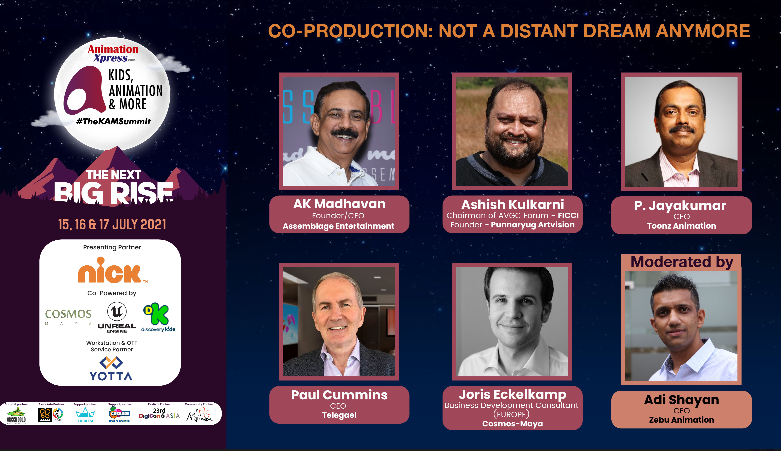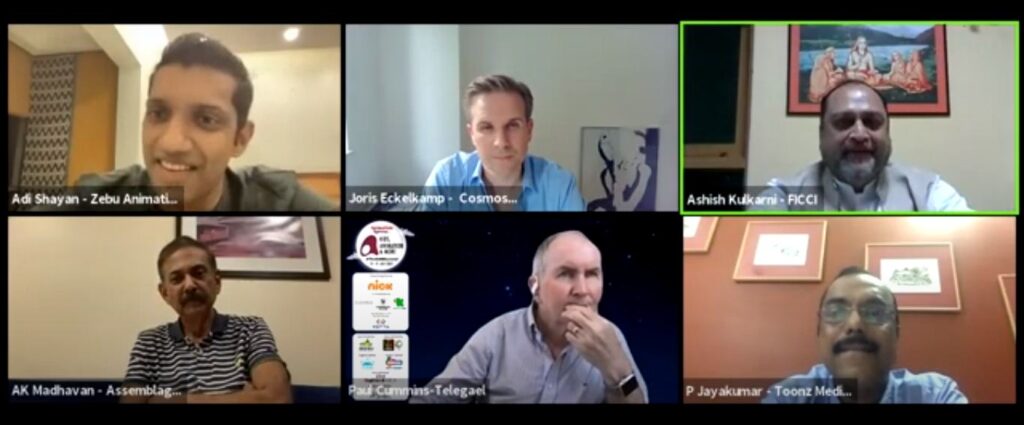
Day one of KAM Summit 2021 witnessed an enriching session on ‘Co-Production: Not a distant dream anymore’ where a discussion over how co-production has been a lucrative opening for the animation sector and what are the different models and challenges being faced in co-production were talked upon.
The panel members included Toonz Media Group CEO P Jayakumar, Assemblage Entertainment founder and CEO AK Madhavan (MadMax), Punnaryug Artvision founder & FICCI chairman of AVGC Forum Ashish Kulkarni, Telegael CEO Paul Cummins, and Cosmos-Maya business development consultant Joris Eckelkamp.
Moderated by Zebu Animation CEO Adi Shayan, the panel discussion began with each member introducing themselves and sharing their perspective about the co-production.
MadMax shared, “Assemblage has been in business for the last seven years and we have done about six full length feature films and most of them were co-productions. Co-production is largely used to milk or take advantage of arbitrage. The arbitrage could be skill oriented, tax exemptions or arbitrage of cultural and faith of expertise and we done all of them in terms of our feature films.”
He further added, “Co-production gives you the experience of being a producer to learn the other areas of production and you also get into the nuances of understanding syndication, distribution, financing and taxes. It is a learning and evolving process.”
Adding to what Madmax said, Kulkarni added, “The main reason for co-production is matching of skills, cost arbitrage and also considering fitting in timelines where you can contribute to the project and put everything together to make sense of co-production.”
He further added, “Lot of co-production mechanisms are effectively working within the country. We have produced two seasons of Shaktimaan. For the first season, we co-produced with Chennai based Excel Animations and the second season was co-produced with a studio based in Hyderabad. And also two of my upcoming projects are also being co-produced within Indian studios.”
Sharing his 30 years of experience in the animation industry, Cummins said, “Animation can be considered as a big part of our production but co-production is very much our model. Since we started about 30 years ago, we have been involved in 100 co-productions, mainly animations. We co-produce with countries like Australia, Germany and we successfully launched many co-produced pre-school and TV animated series.”
Quoting the risk behind co-production Jayakumar elaborated, “We have done several co–production projects, and the essential part is to share the risk and rewards and it is the basic fundamental of co-production. It is difficult to analyse whether the risks and rewards are equitable. In initial stages we did some stupid co-productions, but over a period of time we learned and evolved.”
Highlighting the importance of communication while co-producing, Eckelkamp said, “Communication is the super important key for co-production. You have to choose your partner wisely and you have to ensure that you both find a solution for any problem that arises in the early stage or future, you have to deal with it effectively. I think it is an important task to keep up the communication working throughout the production, and not only in the beginning, to establish a certain communication.”
Commenting about how co-production gets started and what thought process goes into it, Cummins added, “Co-production is all about building networks in the industry of context. Each co-production is different. A lot of time you buildup network of partners where often you reach out to them for future co-pros. Building trust and confidence and delivering what you promised is essential for effective co-production.”
Added key points about how co-production can make use of tax and government fundings, Jayakumar listed, “Co-production all starts from the producer and project; it is all about how you finance the project. Secondly the subsidies and tax collected is basically free money. There are many countries like Spain and Ireland which offer 50 per cent and it is upto you how you find the place to get your project done and get about 30-40 per cent of overall budget free of money.”
He further added, “Co-production is about how you finance the project. As a commissioning broadcaster, you have to look for how to optimally fund the production without losing too much of shares, and how to find your partner. To find the right partner in co-production without losing your shares is a game and for me it was a puzzle game.”

Describing the model and future of what he has planned for himself and Cosmos-Maya, Eckelkamp said, “My hope for the future and plan for Cosmos-Maya is to concentrate on more original IPs because co-production is effectively done based on who owns the IP, who is the producer and who has the project.”
He further added, “The later you are coming into the project and it is already financed, the less share you own and you are in a weaker position as a co-producer. We believe in co-production at an early stage so that the co-development takes place and we join forces with the company by being in a stronger position.”
Claiming that co-production is always an independent studio thing, MadMax said, “We have to understand the origin of co-productions. Big boys like Disney, Warner, DreamWorks don’t do co-production. It is mostly done by independent creators or studios that have gaps in skills, story delivery, design, and predominantly the gap in finance. Co-production doesn’t originate unless and until there is a gap; it may be due to creative reasons, distribution reasons and market reasons.”
Sharing the insights where India has been lacking in means of co-production, Kulkarni said, “Many European countries have excelled in co-production. I am not saying that India has not excelled. But those countries are supported predominantly with government funding. India is lacking because of the absence of government funding and broadcast funding. We have to predominantly depend upon digging out of the studio resources and by making sure that we support the co-production irrespective of the rest of the ecosystem.”
He further added, “India has built its foundation by providing services to the studios across globe and building business and growing the value chain by creating IPs. But for me the real success for India is when Indian stories and Indian original IPs would start seeing the light of day as co-productions.”
Decoding the Japanese model of co-production, Kulkarni added, “Japanese model of co-production is more effective model where the production studio, toy maker, broadcaster, licensing and merchandising guys, all of them come together as co-producers and produce the projects and they don’t have to go out of the country for co-pros. This model is really working well and has been followed for the last 40 years in Japan.”
Concluding the session, Kulkarni spoke about what the future holds for animation co-production mechanisms. He said, “ Blockchain is evolving and the whole co-production mechanism is going to change. It will take people a little time to understand blockchains but with this we can solve the large amount of issues we face during co-production .With NFTs (Non-fungible tokens) and blockchain mechanism, we, the creators, will be able to see the light of the day for some of the shows!”
You can watch the session here https://youtu.be/jMowB29Sxz0 from 1:22:21
